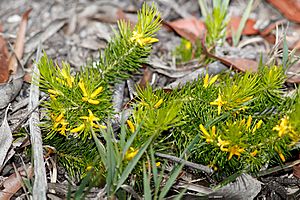Fine-leaf geebung facts for kids
Quick facts for kids Fine-leaf geebung |
|
|---|---|
 |
|
| Persoonia tenuifolia in Bald Rock National Park | |
| Scientific classification | |
| Genus: |
Persoonia
|
| Species: |
tenuifolia
|
| Synonyms | |
|
|
The Persoonia tenuifolia, also known as the fine-leaf geebung, is a special plant. It belongs to the Proteaceae family and grows only in eastern Australia. This plant is a shrub that can stand upright or spread low to the ground. Its young branches are a bit hairy, and its leaves are long and thin. It has pretty yellow flowers that grow in groups of up to eight. These flowers appear on a stem part called a rachis, which is about 2–30 mm (0.079–1.181 in) long and keeps growing even after the flowers bloom.
What Does It Look Like?
The fine-leaf geebung is a shrub that usually grows to be about 20–50 cm (7.9–19.7 in) tall. Its young branches have soft, greyish hairs. The leaves are very narrow, like tiny lines, measuring about 10–25 mm (0.39–0.98 in) long and 0.3–0.5 mm (0.012–0.020 in) wide. They often curve upwards and have a small groove on their underside.
The yellow flowers grow in clusters of up to eight. They are found along a central stem, or rachis, which can be 2–30 mm (0.079–1.181 in) long. Each flower sits on a short, hairy stalk called a pedicel, which is about 1–3 mm (0.039–0.118 in) long. At the base of each flower stalk, there is a small leaf. The flower petals, called tepals, are yellow and about 8–10 mm (0.31–0.39 in) long. They are smooth and do not have hairs. You can usually see these flowers blooming from November to February.
How It Was Named
The fine-leaf geebung was first officially described in 1830 by a famous botanist named Robert Brown. He wrote about it in a special book about plants. The plants he studied were collected in 1827 near a place called Moreton Bay by another botanist, Charles Fraser.
Where It Grows
The fine-leaf geebung likes to grow in open areas called heathlands and in forests. You can find it from places near the ocean all the way up to mountains as high as 1,050 m (3,440 ft).
It grows in coastal areas between Bundaberg in Queensland and Grafton in New South Wales. You can also find it on the Great Dividing Range and the nearby high plains. This includes areas from Dalveen in Queensland down to the Torrington and Yetman regions in New South Wales.

